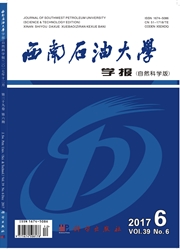

 中文摘要:
中文摘要:
由于地层模型和测量条件不同,随钻和电缆脉冲中子孔隙度测井响应存在差异,对其响应差异研究可为随钻测井解释提供理论依据。利用蒙特卡罗方法建立不同地层模型,模拟不同测井环境条件下响应的差异。结果表明,在随钻测井条件下,热中子计数比值随地层孔隙度增加按三次多项式趋势增加,电缆脉冲中子孔隙度测井响应也具有相同的规律,但随钻和电缆脉冲中子孔隙度测井响应曲线存在交叉点;随钻测井条件下孔隙度相对灵敏度计算值大于电缆测井,但随钻测井条件下的钻铤会降低热中子计数统计性,影响孔隙度测量精度;不同测井环境条件对由于其改变引起的随钻和电缆测井响应差异影响随地层孔隙度增加而减小,岩性、泥质含量和井眼尺寸对随钻测井响应的影响都大于电缆测井,井眼流体为淡水、油或盐水时对脉冲中子孔隙度响应影响可忽略,井眼流体为气时对电缆测井响应的影响大于随钻测井。
 英文摘要:
英文摘要:
Because the formation model and measurement condition are different, the pulsed-neutron porosity logging re- sponseof logging-while-drilling(LWD) is different from that of wireline(WL), so the study on the response difference can provide theoretical basis for the logging interpretation of pulsed-neutron porosity logging while drilling. In this paper, Monte Carlo method is employed to build different models to study the response differences under different logging environments. The results show that the counting ratio under LWD conditions increases in three-order polynomial form with the increase of porosity, and the WL neutron logging response displays the same changing trend, but there is a crossing point in the LWD and WL logging response curves. The relative sensitivity to porosity in LWD is greater than that in WL, but the drilling collar in LWD tool can reduce the counting statistics of thermal neutron, which may influence the measurement accuracy. The effect of different logging environments on the logging response of LWD and WL decreases with the increaseof porosity. The effect of lithology, shale content and borehole size on the logging response difference of LWD is larger than that of WL. When the borehole is filled with fresh water, oil and brine, the effect on logging response is slight and can be ignored. While the borehole is full of gas, the effect on logging response of LWD is smaller than WL.
 同期刊论文项目
同期刊论文项目
 同项目期刊论文
同项目期刊论文
 期刊信息
期刊信息
